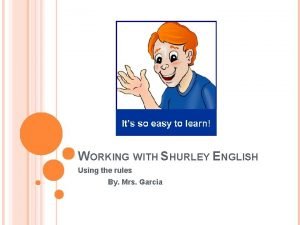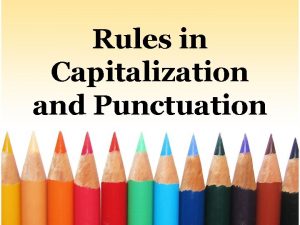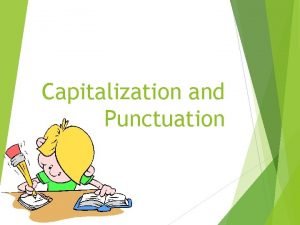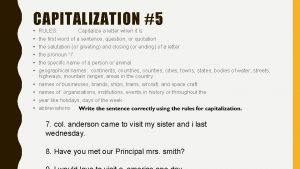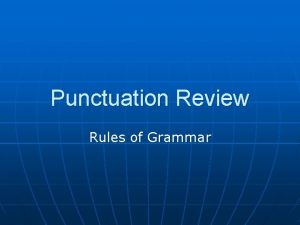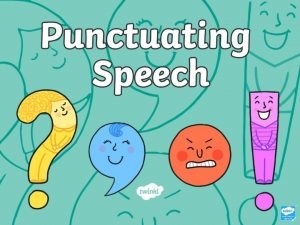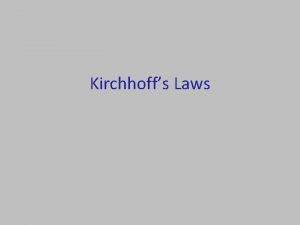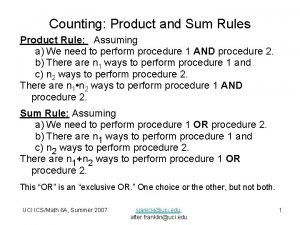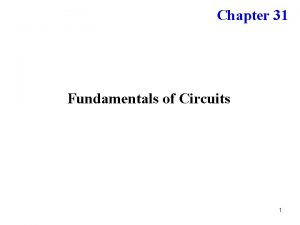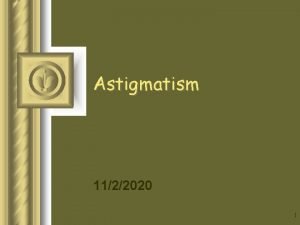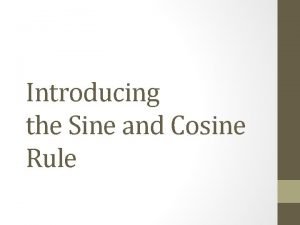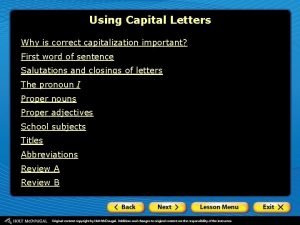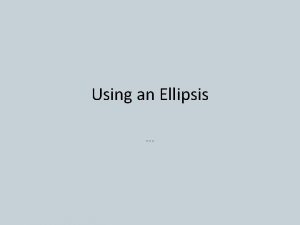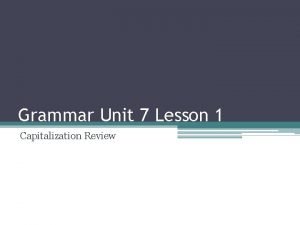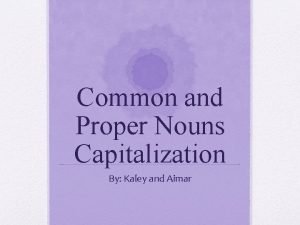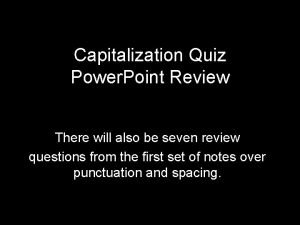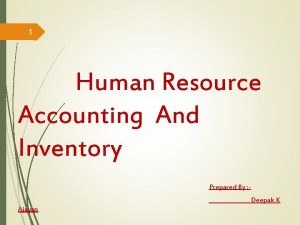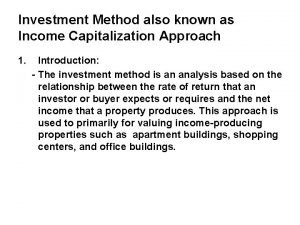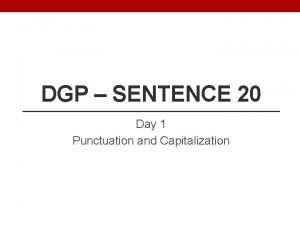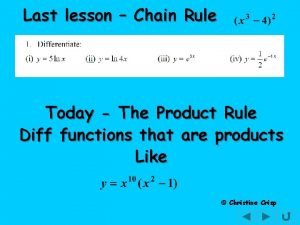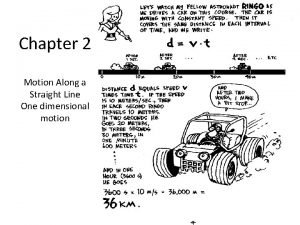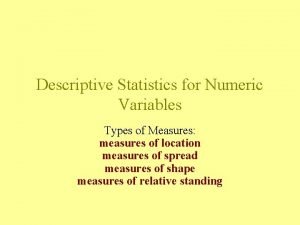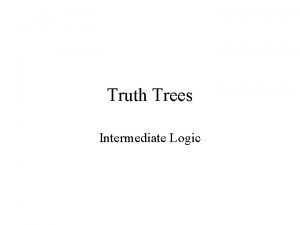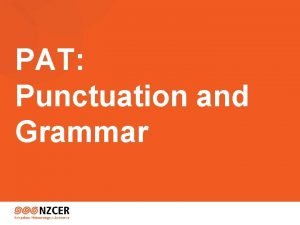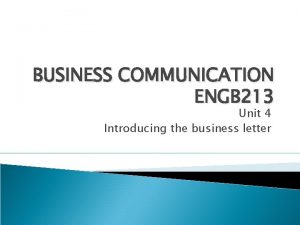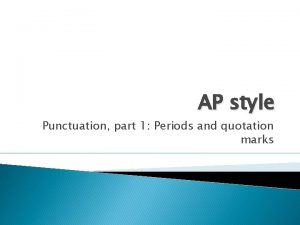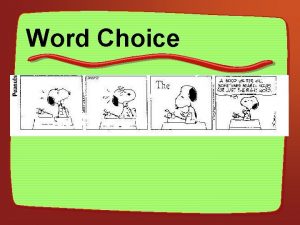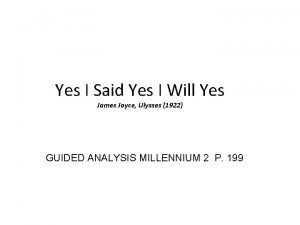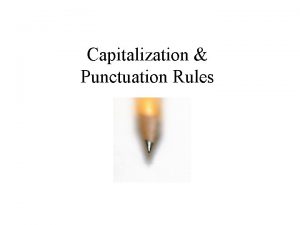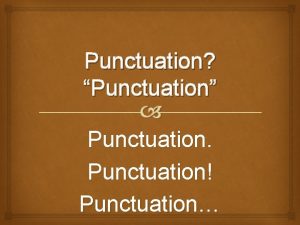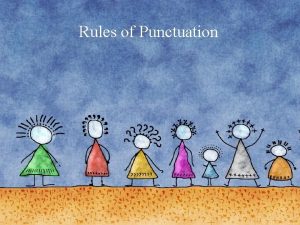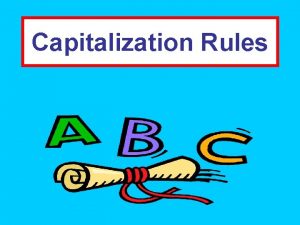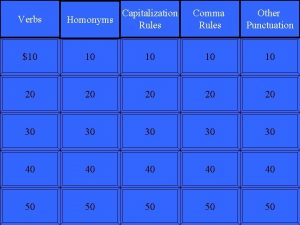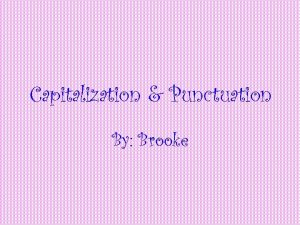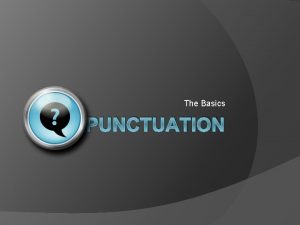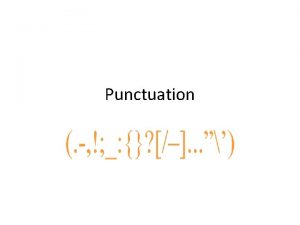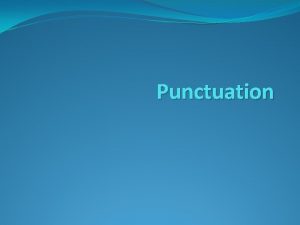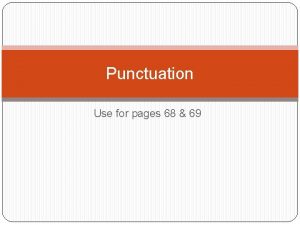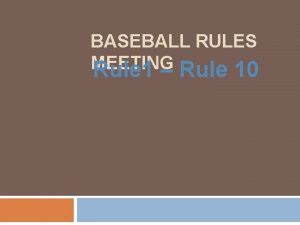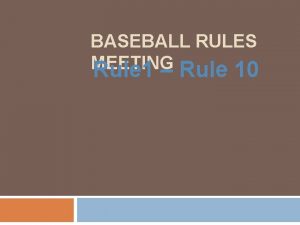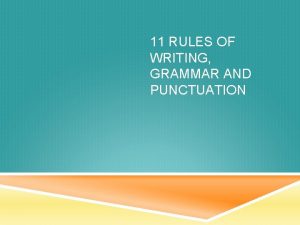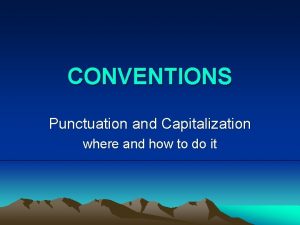Rules in Capitalization and Punctuation Capitalization RULE NO























































- Slides: 55

Rules in Capitalization and Punctuation

Capitalization

RULE NO. 1 Capitalize the first word of a quoted sentence.

• He said, "Treat her as you would your own daughter. “ • "Look out!" she screamed. "You almost ran into my child. "

RULE NO. 2 Capitalize a proper noun.

• Golden Gate Bridge • Dr. Jose P. Rizal • Pasig Catholic College

RULE NO. 3 Capitalize a person's title when it precedes the name. Do not capitalize when the title is acting as a description following the name.

• Chairperson Petrov • Ms. Petrov, the chairperson of the company, will address us at noon.

RULE NO. 4 Capitalize the person's title when it follows the name on the address or signature line.

• Sincerely, Ms. Haines, Chairperson • Yours truly, Dr. Rolando P. Castro, Dean

RULE NO. 5 Capitalize the titles of highranking government officials when used before their names. Do not capitalize the civil title if it is used instead of the name.

• The president will address Congress. • President Noynoy Aquino delivered his SONA last week.

RULE NO. 6 Capitalize any title when used as a direct address.

• Will you take my temperature, Doctor? • Do you have a court hearing, Attorney?

RULE NO. 7 Capitalize points of the compass only when they refer to specific regions.

• Go south three blocks and then turn left. • We live in the southeast section of town.

RULE NO. 8 Always capitalize the first and last words of titles of publications regardless of their parts of speech. Capitalize other words within titles, including the short verb forms Is, Are, and Be. Do not capitalize little words within titles such as a, an, the, but, as, if, and, or, nor, or prepositions, regardless of their length.

• Capitalize other words within titles, including the short verb forms Is, Are, and Be. • Do not capitalize little words within titles such as a, an, the, but, as, if, and, or, nor, or prepositions, regardless of their length.

• The Day of the Jackal • What Color Is Your Parachute? • A Tale of Two Cities

RULE NO. 9 Capitalize federal or state when used as part of an official agency name or in government documents where these terms represent an official name. If they are being used as general terms, you may use lowercase letters.

• That is a federal offense. • The Federal Bureau of Investigation has been subject to much scrutiny and criticism lately. • We will visit three states during our summer vacation.

RULE NO. 10 Capitalize the first word of a salutation and the first word of a complimentary close.

• Dear Ms. Pedroza: • My dear Mr. Sanchez: • Very truly yours,

RULE NO. 11 After a sentence ending with a colon, do not capitalize the first word if it begins a list.

• These are my favorite foods: chocolate cake, spaghetti and adobo. • These are my skills: programming, driving and multitasking.

RULE NO. 12 Do not capitalize names of seasons.

• I love autumn colors and spring flowers. • Philippines has summer and rainy seasons.

Top Ten Rules in Punctuation

COMMA (, ) • Use commas to separate independent clauses in a sentence when they are joined by a coordinating conjunction. Example: 1. The game was over, but the crowd refused to leave. 2. Yesterday was her brother’s birthday, so she took him out to dinner.

These are the Coordinating Conjunctions (FANBOYS): For And Nor But Or Yet So

COMMA • Use commas after introductory words, phrases, or clauses that come before the main clause Examples: 1. While I was eating, the cat scratched at the door. 2. If you are ill, you ought to see a doctor.

COMMA • Use a pair of commas to separate an aside from the main body of the sentence. Example: 1. John and Inga, the couple from next door, are coming for dinner tonight.

COMMA • Use commas to set off all geographical names, items in dates (except the month and day), addresses (except the street number and name), and titles in names. Example: 1. Birmingham, Alabama, got its name from Birmingham, England. 2. July 22, 2011, was a momentous day in his life.

COMMA • Use a comma to shift between the main discourse and a quotation. Example: 1. John said without emotion, “I’ll see you tomorrow. ” 2. “I was able, ” she answered, “to complete the assignment. ”

Period (. ) • The primary use of a period is to end a sentence. Example: 1. Business English is very important for your professional growth.

Period (. ) • Its second important use is for abbreviations. Examples: 1. Jesus Christ was born c. 4 -6 AD 2. Mr. Jose was happy to see his wife.

Question Mark (? ) • It goes at the end of a sentence which is a question. Examples: 1. What can you do for the company? 2. How can you be an asset?

Exclamation Point (!) • This is used in ending extreme emotions expressed in a sentence. Example: 1. Ouch! 2. Fire!

Quotation marks (“ ”) • are used to quote another person’s words exactly, whether they be spoken, or written Examples: 1. John said, “We are going shopping. ” 2. As D. H. Nachas explains, “The gestures used for greeting others differ greatly from one culture to another. ”

6. Quotation marks (“ ”) • used to denote irony or sarcasm, or to note something unusual about it Example: 1. The great march of “progress” has left millions impoverished and hungry.

Colon (: ) • used after a complete statement in order to introduce one or more directly related ideas, such as a series of directions, a list, or a quotation or other comment illustrating or explaining the statement Example: 1. The daily newspaper contains four sections: news, sports, entertainment, and classified ads.

Colon (: ) • used to separate chapter and verse from the bible or to separate hours, minutes, and seconds Example: 1. John 1: 21 2. 09: 25: 12

Semicolon (; ) • Use a semicolon to join related independent clauses in compound sentences Example: 1. Jim worked hard to earn his degree; consequently, he was certain to achieve a distinction. 2. Jane overslept by three hours; she was going to be late for work again.

Semicolon (; ) • used to separate items in a series if the elements of the series already include commas Example: 1. Members of the band include Harold Rostein, clarinetist; Tony Aluppo, tuba player; and Lee Jefferson, trumpeter.

Apostrophe ( ’) • to form possessives of nouns Example: 1. the boy’s hat 2. three day’s journey

Apostrophe ( ’) • to show the omission of letters Example: 1. He’ll go = He will go 2. could’ve = could have

Apostrophe ( ’) • to form plurals of letters Example: 1. Mind your p’s and q’s.

Parentheses ( ) • occasionally and sparingly used for extra, nonessential material included in a sentence Example: 1. Before arriving at the station, the old train (someone said it was a relic of frontier days) caught fire.

Hyphen or dash (-) • Dashes separate • Hyphens join

Hyphen • Use a hyphen to join two or more words serving as a single adjective before a noun Example: 1. chocolate-covered peanuts 2. Two-storey house

Hyphen • Use a hyphen with compound numbers Example: 1. Forty-five 2. Sixty-two

Hyphen • Use a hyphen with the prefixes ex- (meaning former), self-, all-; with the suffix -elect; between a prefix and a capitalized word; and with figures or letters Example: 1. ex-husband 2. t-shirt

Dash • Use the dash to emphasize a point or to set off an explanatory comment; but don’t overuse dashes, or they will lose their impact; typically created in wordprocessing by two hyphens with no spaces before, after, or between the hyphens Example: 1. To some of you, my proposals may seem radical— even revolutionary.

Dash (-) • used for an appositive phrase that already includes commas Example: 1. The boys–Jim, John, and Jeff–left the party early.

Thank you !
 Shurley english capitalization rules
Shurley english capitalization rules Rules for capitalization
Rules for capitalization Deparchure
Deparchure Correct capitalization and punctuation
Correct capitalization and punctuation Capitalization in titles mla
Capitalization in titles mla 5 rules of capitalization
5 rules of capitalization Mints for capitalization
Mints for capitalization When to use a comma before and
When to use a comma before and Split direct speech worksheet
Split direct speech worksheet Punctuation reported speech
Punctuation reported speech When to use sine rule or cosine rule
When to use sine rule or cosine rule Sine rule and cosine rule
Sine rule and cosine rule Kirchoff's junction rule
Kirchoff's junction rule Rules of sum and product
Rules of sum and product Kirchhoff's loop law equation
Kirchhoff's loop law equation Oblique astigmatism definition
Oblique astigmatism definition Compound astigmatism example
Compound astigmatism example Astigmatism classification
Astigmatism classification Can sine rule be used on right angled triangles
Can sine rule be used on right angled triangles Letter salutation capitalization
Letter salutation capitalization Ellipsis in conversation
Ellipsis in conversation Capitalization grammar
Capitalization grammar Capitalization
Capitalization Which css property configures the size of text?
Which css property configures the size of text? Which css property configures the font typeface
Which css property configures the font typeface Schoolhouse rock capitalization
Schoolhouse rock capitalization Proper nouns capitalization
Proper nouns capitalization Salutation capitalization
Salutation capitalization Cisco market capitalization
Cisco market capitalization Capitalization
Capitalization Capitalization
Capitalization Do you capitalize moon
Do you capitalize moon Agile software development capitalization
Agile software development capitalization Human resources inventory
Human resources inventory Yp in perpetuity
Yp in perpetuity Who wants to sign up to hear stefano's band in concert
Who wants to sign up to hear stefano's band in concert Reciprocal and quotient identities maze
Reciprocal and quotient identities maze Home rule vs dillon's rule
Home rule vs dillon's rule Product rule
Product rule Chain rule範例
Chain rule範例 Chain rule power rule
Chain rule power rule Tukey's rule vs empirical rule
Tukey's rule vs empirical rule Rules in filling up the apartment aufbau principle
Rules in filling up the apartment aufbau principle F subshell
F subshell Truth trees
Truth trees Unlike traditional production rules, association rules
Unlike traditional production rules, association rules However punctuation
However punctuation Inside address
Inside address Pat grammar and punctuation
Pat grammar and punctuation Fully blocked open punctuation
Fully blocked open punctuation Ap style punctuation inside quotes
Ap style punctuation inside quotes Word choice and punctuation in a cartoon
Word choice and punctuation in a cartoon How to use punctuation in quotes
How to use punctuation in quotes I will yes
I will yes Instead of punctuation
Instead of punctuation Math punctuation
Math punctuation
